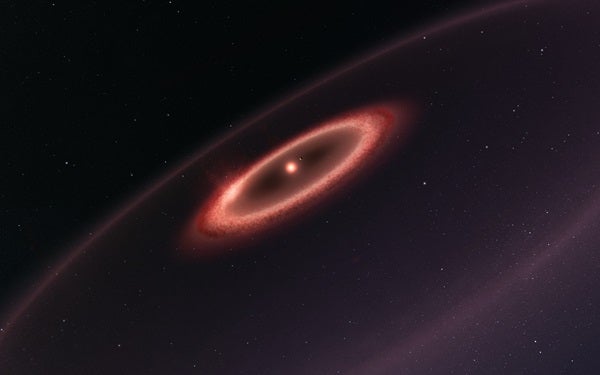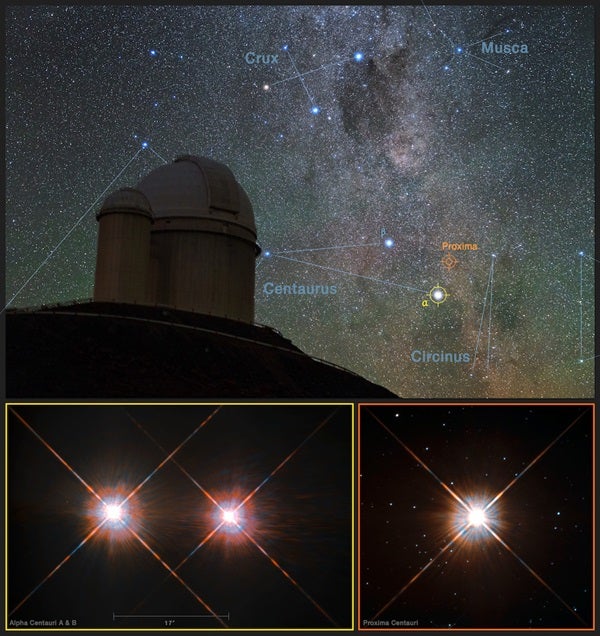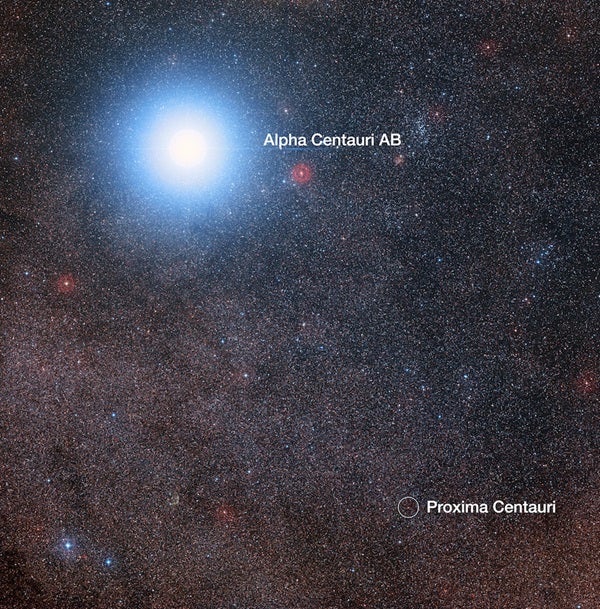Anglada-Escude is a coauthor on a paper today by a team led by the completely-unrelated-at-all-but-same-named Guillem Anglada regarding the presence of several rings of dust. Anglada-Escude (not to be mistaken for Anglada) talked to us about the ring finding, what it means for nearby planets, and what the next steps are in our quest to understand the Proxima Centauri system — and maybe find a few more planets along the way.
How was the interior belt discovered?
This comes after the discovery of the planet last year, or even before it was announced that people in Granada, which has a very good group in millimeter and submillimeter [radio astronomy]. [T]here’s some evidence in other systems that when there are close-in planets, there tend to be dust belts in long period orbits. That was the obvious thing, to see if there was a dust belt. To our surprise, no one had tried this before, so we asked for some ALMA time. The observation was carried out, and we got the first confirmation that there was some excess signal from the star, and things followed from there.
It’s a bit like our solar system. When you see dust belts and smaller particles, it’s an asteroid belt. What’s probably there is an asteroid belt like our own, or several of them. We can confirm that there’s a three ring structure, so if that’s the case, it means there are objects that are probably shepherding all this dust and asteroids and they’re staying there. It’s not that they put the dust there. It’s that these orbits are stable over long timescales.
It’s like Saturn’s rings. You have structure, and you have gaps where the orbit is unstable and the dust remains where it’s comfortable.
Do you have any preliminary indication of these planets through RedDots?
From the radial velocity, we don’t see evidence of a long period gas giant. What we see is evidence is that maybe there is something there, but we need more radial velocity measurements.
There is evidence of an object at half an astronomical unit (AU), but this is very tentative. It’s not confirmed, but we committed to putting the data to the public. At this point, there’s a signal there, but we’re not sure if it’s caused by stellar activity or the presence of a planet or something else happening there.
In the dust paper, there seems to be a point source at 1.6 AU. We don’t see evidence for anything in the radial velocity there. That doesn’t mean there’s nothing there, just that the radial velocity is not attuned to an object there, which makes it unlikely that there’s a gas giant there.
With a planet at 0.5 AU, does that interact with the warm dust you saw at 0.4 AU?
That would be the expectation. This object might be one of the shepherd objects that shapes the ring if the object is real. This first paper is a preliminary snapshot, just reporting the evidence that there of these rings, and that the detection is very strong, but we still don’t know the structure of these rings. But there are several hints because this is a discovery process. Now we have to see if this planet is there, and we need a better picture of the rings to see what they have, and as the pieces of the puzzle come together, we’ll see progress.
We could use more ALMA time, that’s one thing. That’s one of the reasons why we wanted to get this published, because we wanted to reapply but we need much more telescope time, and ALMA time is difficult to get because a lot of people want to use the instrument. That’s one very obvious thing, especially for seeing these ring structures so we can pin down the gaps and rings.
Another thing is to look for planets with radial velocity measurements. We need to analyze the data. We already have it. So maybe in a few months we’ll be convinced that the second signal is a planet. But who knows.
There are maybe some experiments that could be done in optical wavelengths to see the rings, but that would be difficult. We need to write down the numbers and see what’s really feasible with what we have, but I’m pretty sure other people would jump in. That’s one of the nice things about this sort of research.
If this outer belt is there at 30 AU, has there ever been an equivalent of that seen? The 1-4 AU belt has been mentioned more as the Kuiper analog.
At 30 AU, that would also be the outer Kuiper Belt limits. In our solar system, the Kuiper Belt is truncated due to the presence of Jupiter and Saturn. If we didn’t have Jupiter and Saturn, our asteroid belt would extend all the way out to the Kuiper Belt. That might be the same situation here. You see a ring outside because an object there, like a planet, is cleaning up this Kuiper Belt at 4 AU.
Out of curiosity, aside from the second radial velocity signature at Proxima, how are the RedDot searches at Barnard’s Star and Ross 154 going?
We have a lot of data on Barnard’s Star and Ross 154. The thing I can say at this point is that this answer is very complicated. There’s data from four or five other instruments that we are combining all together. We should be able to report what we found there within a few months, but at this point we can’t really tell because the data set is complicated. We’re still discussing and trying to build a consensus on what is there.
At Ross 154 or Barnard’s star or both?
If we find something around Barnard’s star, we will be reporting it big time as well, because that will be a wonderful thing because it’s nearby and we’d expect to do follow-up studies of all sorts. [EDITOR’S NOTE: in 1963, there was a later refuted claim of a gas giant in the Barnard’s Star system by Peter van de Kamp at Sproul Observatory]
Do you have any other thoughts?
If you want to see how science works, you’ll notice that some people overlap with the planet paper, but others do not. The follow-up effort is not just doing the same thing. It’s coming together like this.












